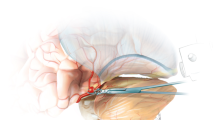Abstract
Proximally located posterior communicating artery (PCoA) aneurysms, projecting postero-laterally in proximity to the tentorium, may pose a technical challenge for microsurgical clipping due to obscuration of the proximal aneurysmal neck by the anterior petroclinoid fold. We describe an efficacious technique utilizing fenestration of the anterior petroclinoid fold to facilitate visualization and clipping of PCoA aneurysms abutting this aspect of the tentorium. Of 86 cases of PCoA aneurysms treated between 2003 and 2013, the technique was used in nine (10.5 %) patients to allow for adequate clipping. A 3 mm fenestration in the anterior petroclinoid ligament is created adjacent and lateral to the anterior clinoid process. This fenestration is then widened into a small wedge corridor by bipolar coagulation. In all cases, the proximal aneurysm neck was visualized after the wedge fenestration. Additionally, an adequate corridor for placement of the proximal clip blade was uniformly established. All cases were adequately clipped, with complete occlusion of the aneurysm neck and fundus with preservation of the PCoA. There were two intraoperative ruptures not related to creation of the wedge fenestration. One patient experienced post-operative partial third nerve palsy, which resolved during follow-up. We describe a technique of fenestration of the anterior petroclinoid fold to establish a critical and safe corridor for both visualization and clipping of PCoA aneurysms.



Similar content being viewed by others

Abbreviations
- PCoA:
-
Posterior communicating artery
- ICA:
-
Internal carotid artery
References
Kim JH, Kim JM, Cheong JH, Bak KH, Kim CH (2009) Simple anterior petroclinoid fold resection in the treatment of low-lying internal carotid-posterior communicating artery aneurysms. Surg Neurol 72:142–145
Rhoton AL Jr (2002) Aneurysms. Neurosurgery 51:121–158
Rhoton AL Jr (2002) The cavernous sinus, the cavernous venous plexus, and the carotid collar. Neurosurgery 51:375–410
Sanai N, Caldwell N, Englot DJ, Lawton MT (2012) Advanced technical skills are required for microsurgical clipping of posterior communicating artery aneurysms in the endovascular era. Neurosurgery 71:285–294
Umansky F, Valarezo A, Elidan J (1994) The superior wall of the cavernous sinus: a microanatomical study. J Neurosurg 81:914–920
Conflict of interest
None
Author information
Authors and Affiliations
Corresponding author
Additional information
Comments
Samuel L. Barnett, Dallas, USA
In this study, the authors describe their technique for fenestrating the anterior petroclinoid fold to permit safe clip reconstruction of select posterior communicating artery (PCoA) aneurysms. The authors have utilized this surgical maneuver in nine cases out of 86 PCoA aneurysms treated surgically over the past 10 years. Their indication for this technique are those aneurysms in which the petroclinoid fold obscured visualization for proximal control or clip placement and the carotid artery was too tortuous or atherosclerotic to allow for medial mobilization. An excellent illustration and several instructive intraoperative photos are included which demonstrate the technique. Their results have been excellent with only one partial third nerve palsy that resolved during the follow-up period. Although I suspect that many neurosurgeons have used a variation of this technique when dealing with these aneurysms, this is a well-written report describing a very useful intraoperative maneuver. I believe every aneurysm surgeon will want to keep this move in their bag of tricks if the need arises.
Ryan P Morton, Louis J Kim, Washington, USA
The authors present a technical report describing the fenestration of the anterior petroclinoid ligament to enhance aneurysmal neck visualization for clipping of select PCOMM aneurysms. They used this operative maneuver for ∼10 % of their PCOMM aneurysms over a 10-year experience and noted that it was most useful when tortuosity/atherosclerosis of the supraclinoid ICA displaced the origin of the PCOMM laterally and underneath the anterior petroclinoid ligament. They do an excellent job describing the indications for this maneuver and the technical nuances to how it is accomplished.
Critically, the third nerve must be identified before this fenestration is attempted in order to not cause unintended morbidity. The illustrations and intraoperative pictures are quite well done and helpful. Lastly, and importantly, the authors stress that this maneuver does not replace an anterior clinoidectomy, which has entirely different indications.
Electronic supplementary material
Below is the link to the electronic supplementary material.
(M4V 8962 kb)
Rights and permissions
About this article
Cite this article
Nossek, E., Setton, A., Dehdashti, A.R. et al. Anterior petroclinoid fold fenestration: an adjunct to clipping of postero-laterally projecting posterior communicating aneurysms. Neurosurg Rev 37, 637–641 (2014). https://doi.org/10.1007/s10143-014-0554-6
Received:
Revised:
Accepted:
Published:
Issue Date:
DOI: https://doi.org/10.1007/s10143-014-0554-6



